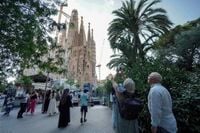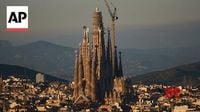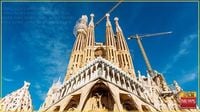Barcelona’s skyline has gained a new, record-breaking silhouette. The Sagrada Familia, Antoni Gaudí’s monumental basilica, officially became the tallest church in the world this week, after workers installed the first section of a massive cross atop its central tower. With this addition, the basilica now rises to an astonishing 162.91 meters (535 feet), finally surpassing Germany’s Ulm Minster, which had held the title since 1890, as reported by the Associated Press and ACI Prensa.
The milestone came on October 30, 2025, when crane operators delicately lifted the lower portion of the cross—an engineering marvel in itself—into place at dizzying heights above the city. According to the Sagrada Familia Expiatory Church Construction Board Foundation, the newly installed section of the cross stands more than 20 feet high, weighs 24 tons, and boasts a double-twist geometry. Its base is square, transforming into an octagonal shape at the top, and the exterior is clad in white glazed ceramic and glass, materials chosen for their reflective properties and resistance to Barcelona’s varied weather. The installation marks the start of the final phase of construction for the church’s central Tower of Jesus Christ—the tallest of the basilica’s planned spires.
This latest addition is more than just a feat of architecture and engineering; it is a tribute to the vision and genius of Antoni Gaudí, who took over the Sagrada Familia project in 1883. Originally designed by Francisco de Paula del Villar, the first stone of the basilica was laid on March 19, 1882. Gaudí, whose name is now synonymous with Barcelona’s unique architectural landscape, radically transformed the project, infusing it with his signature Modernist style and deep religious symbolism. From 1914 until his death in 1926, Gaudí dedicated himself exclusively to the basilica, though he lived to see only one of its eighteen planned towers completed.
Gaudí’s legacy continues to loom large over the Sagrada Familia, both literally and figuratively. Despite facing daunting setbacks—wars, fires, and chronic funding shortages—the project has pressed on for more than 140 years. The Spanish Civil War proved especially devastating, destroying much of Gaudí’s original models and plans. More recently, the Covid-19 pandemic forced a temporary halt in construction as tourism, the basilica’s main source of funding, dried up. Yet, as the Sagrada Familia Foundation notes, the project has survived, thanks in large part to the steady support of visitors and private donors.
The completion of the central tower is set for 2026, a date chosen to coincide with the centenary of Gaudí’s death. But the basilica’s story doesn’t end there. Further decorative and structural work is expected to continue well into the 2030s, ensuring that future generations will witness the evolution of this extraordinary building. As the foundation put it, the completion of the Tower of Jesus Christ "will be a historic milestone for Sagrada Familia and a tribute to its architect."
Crane operators, working at heights over 150 meters, have played a crucial role in this latest achievement. Their behind-the-scenes efforts have allowed the Sagrada Familia to continue its upward trajectory, quite literally raising the basilica toward the heavens. The project’s technical demands have required a blend of traditional craftsmanship and cutting-edge technology, a testament to the enduring spirit of innovation that Gaudí himself championed.
Gaudí’s influence extends beyond architecture. On April 14, 2025, Pope Francis declared the architect venerable, recognizing his life and work as a model of Christian virtue. This designation, announced in accordance with the criteria set by the Dicastery for the Causes of Saints, adds a new spiritual dimension to the basilica’s long history. For many, the Sagrada Familia is not just a building—it is a living symbol of faith, perseverance, and the enduring power of human creativity.
The Sagrada Familia’s journey from a modest parish church to the world’s tallest basilica is a story of ambition, adversity, and awe-inspiring artistry. Construction began at a time when Barcelona was rapidly modernizing, and Gaudí’s vision quickly outgrew the original plans. Over the decades, the basilica has become a magnet for both pilgrims and tourists, drawing millions each year who marvel at its intricate facades, soaring columns, and kaleidoscopic stained glass. The basilica’s unique blend of Gothic and Art Nouveau elements has made it one of the most recognizable—and beloved—landmarks in the world.
Yet the Sagrada Familia is more than a tourist attraction. For the people of Barcelona, it is a symbol of resilience and hope. The basilica has weathered some of the darkest chapters in Spanish history, from civil war to dictatorship, and emerged as a beacon of cultural and spiritual renewal. Its ongoing construction is a reminder that great works take time—and that the pursuit of beauty and meaning is a journey, not a destination.
With the installation of the cross’s lower portion, the basilica now stands as a testament to what can be achieved when vision, faith, and community come together. The cross itself, with its reflective surfaces and intricate geometry, is designed to catch the light of the sun and cast it across the city—a fitting metaphor for the role the Sagrada Familia has played in Barcelona’s life for nearly a century and a half.
As work continues, the world watches with anticipation. The final completion of the Tower of Jesus Christ, scheduled for 2026, promises to be a momentous occasion, not only for Barcelona but for admirers of architecture and history everywhere. And while the basilica’s story is far from over, this week’s achievement marks a new chapter in the ongoing saga of one of humanity’s greatest architectural endeavors.
For now, the Sagrada Familia reigns as the tallest church in the world—a towering symbol of enduring faith, artistic genius, and the remarkable capacity of people to dream big and build even bigger.


